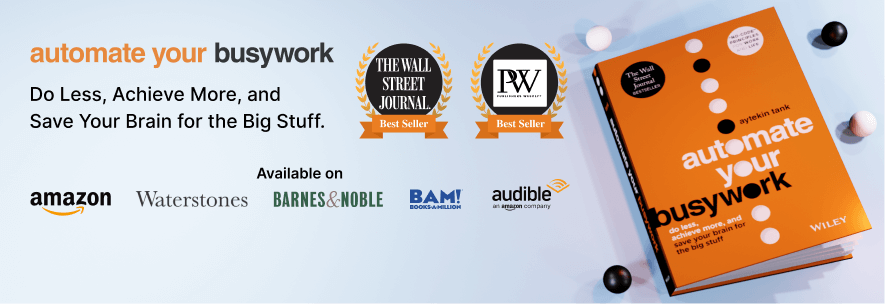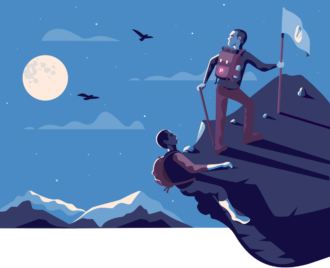He loves to talk about work. Well, he loves to complain about his boss.
It’s almost 2018, yet he STILL thinks the only way to market our shampoo brand is by running expensive ads on TV.
Relaxing with a cold beer, I have no issues spending the evening discussing our jobs.
But I know that soon enough, we’ll be comparing the two — very different — paths we’ve taken since leaving college: his offline corporate world vs. my online startup life at JotForm.
And as usual, the main topic will be how his company — with its ‘old-fashioned mindset’ — is still ignoring the power of today’s digital channels.

He’s a Senior Brand Manager at a giant consumer goods corporation; they own most of the products we see on our supermarket shelves.
I tune back into his rant.
“Now it’s all about AI, AR and VR? Are you kidding me!?” he shouts. “I’ve only just managed to convince my boss to give me a budget for Instagram and influencer marketing,”
Passive recipient yesterday, hyper-empowered today
It’s true that the best way to sell a shampoo brand used to be ‘top-of-mind marketing’ which has been the century-old marketing method that required spending a massive advertising budget on TV, magazines, radio and newspapers.
The goal was to run repetitive ads to become the ‘top-of-mind’ brand — i.e., the first brand that comes to mind when customers were ready to buy a certain product.

The customer was a passive recipient. In the middle of her favourite TV shows, she was constantly being interrupted with the:
We’ve got great stuff. Buy it.”message of those brands.
Times have changed since then, and so have technologies. But for many companies, ‘top-of-mind marketing’ hasn’t.
Their marketers approached the newly-born Twitter or Instagram the same way they approached TV. In their eyes, these were just new platforms on which to scream their “Buy my awesome stuff” message.
It was the same shouting with a different megaphone, just via 140 characters at a time.
While some marketers resisted to change, consumers didn’t.
As David Ogilvy, the father of advertising once said: The consumer isn’t a moron.
She is smart enough to figure out how to use today’s technologies and tools to her advantage.
She knows how to block our ads, stream content through ad-free subscription services, close our annoying signup pop-ups and unsubscribe forever.
Think you’re the best? She can find out where you stand against the competition in seconds, with the all the info in the world at her fingertips.
She doesn’t blindly believe what you tell her anymore. After all, reviews, user-generated content, and influencers have emerged as the three major forces driving consumer behavior today.

No longer a passive recipient, she is hyper-empowered, hyper-connected, demanding and impatient.
In a world where she can make or break a company with a single click, the question is:
What IS left in the marketer’s control?
As Mark Schaefer recently put:
- What is marketing today when our brand messaging is created by the hive mind instead of our ad agency?
- What does marketing mean any more when nobody trusts your company and the world is blocking your ads?
- We need to transcend our silos and even our instincts to embrace the chaos.
- We need to build organizations that stop fighting the hyper-powered consumer and find ways to encourage her.
The future of marketing is in the past.
Conversations have always been the starting point of marketing.
Just look at the past. Before any evolutions of the modern era, we would sell our wares — a loaf of bread, a horse and carriage — by engaging with a potential customer. In real-time, one-to-one.
But the more we’ve advanced technologically, the further we’ve removed ourselves from this dialogue.
Instead, we choose to blast people from a distance with cold calls, pop-ups, paywalls, automated emails, and adverts.We group individuals into the mass category of leads and conversions: faceless entities that exist only on our spreadsheet.
Sounds horrible for the customer, doesn’t it? Well, it’s horrible for your business, too.
There’s a reason a typical landing page conversion rate is 2.35%, and the average email open rate is only 20%.
The way we’ve been marketing is broken. But the good news is, we already know how to fix it.
In Jay Baer’s words, it starts by employing more of “friend-of-mine awareness” instead of relying on “top-of-mind awareness” alone:
I call this friend-of-mind awareness, and it’s predicated on the reality that companies are competing against real people for the attention of other real people.
To succeed, your prospective customers must consider you as a friend.
And if, like their friends, you provide them real value, they will reward your company with loyalty and advocacy, the same ways we reward our friends.
But how can we distinguish a good friendship?
We can (almost) read their minds

We used to rely on ‘target markets’, ‘key publics’ and broad categories such as high and low end.
But this logic is outdated. I might fly first class across the world on the same day I make a beeline for the ‘reduced’ section at my local grocery story.
The reality is, segmentation has never been more complex, because people have never been more complex.
We can’t cram our customers into little boxes anymore; they are too connected, too well-informed.
As I outlined in my last story, we are moving from mass marketing to mass personalization with a focus on individuality.
The ‘one-size-fits-all’ mindset is on its last legs. Instead, a more holistic approach that treats consumers as people — with emotions, habits, and experiences — takes center stage in the future of marketing.
Once a buzzword, personalization in itself has ceased to surprise and delight the way it used to. In fact, most customers these days have come to expect it. As Brian Wong, founder and CEO of Kiip, argues,
…personalisation is no longer enough; we need to create experiences that allow consumers to act on that content.
This means looking to the future to foresee the next step on your customer’s journey — and connecting the dots for them.
And thanks to today’s countless tools or big data, it’s never been easier to understand what our hyper-empowered customer wants to do next — before they’ve worked it out themselves.
We show them we care
While we were busy converting strangers into leads and forcing them down funnels, we forgot about the most important people — our existing customers.
As I’ve written recently, a key factor in sustaining growth is framing every decision — designing every function — on a customer-centric basis.
After all, a five percent increase in customer retention can increase a company’s profitability by 75%.
Or, to break it down even further: keeping an existing customer happy costs 11% of what it costs to acquire a new customer.
Essentially, it’s always worth playing the long-game.
Of course, this isn’t a game of either/or. Customer-centered growth is as much an acquisition tactic as it is a retention tactic.
This approach relies on the consistent offering of extreme value — without an ulterior motive. It means maintaining a constant connection with your customers, an honest dialogue that goes both ways.
Such a dialogue involves moving beyond talking about our core product and starting to help them.
If you sell something, you make a customer today; if you help someone, you make a customer for life. — J. Baer
We need to reward our customers at every stage of their journey, from the first point of engagement to the last — not just one static snapshot in time.
We could chat to them for hours
Business Insider recently reported that combined usage of the top four messaging apps exceeded the combined usage of the top four social media apps.
Yep, messaging is overtaking the once-invincible social media.
We already know that the average open rate for an email is 20%. The open rate for a private message? 98%.
Let that sink in.
According to studies, 44% of online consumers consider having a live chat while shopping online one of the most important features a website can have.
Tools like Drift or Intercom allow you to set one up in minutes.
Another option is to use a pre-existing platform such as Facebook Messenger, Slack, Discord, Telegram or Kik for your bot to live happily ever after on.
We listen to their needs
Don’t you hate it when someone talks over you?
What about when someone sits down, really listens, and takes everything you say onboard?
Sounds like a no-brainer.
That’s one way of looking at outbound vs interactive marketing. The latter encourages two-way dialogue between the company and the customer; pulling, rather than pushing them in.
Kind of like playing in a tennis match instead of smacking a ball off a brick wall by yourself.
At Jotform, we are embracing interactivity with open arms. Since our product revolves around helping companies show their customers they’re listening, we hope we’ve gotten pretty good at listening ourselves, too.
And with over 3.2 million users — who, in turn, use Jotform to communicate with all of their users — we have a fair few people to listen to.
That’s why we’re always asking our users for feedback on how we can improve. Our ear never leaves the ground. To listen to the latest tech trends, yes, but most importantly, to hear what all of our friends out there have to say.
So think of feedback — even the negative kind — as a gift. The customer is giving you an opportunity to transform their view of your brand, depending on how you choose to respond and move forward.
Who knows — an angry email or a complaint could be your chance to win over a new superfan.
OUR POWERLESS FUTURE
Not long ago, a marketer’s role was to plan a campaign, execute it, analyze the results. Rinse and repeat. Every step could be tightly-controlled, every action premeditated.
But today, we no longer have this authority. Technology has handed customers unprecedented power to dictate the rules.
They can thrust us into overnight success, or destroy our entire reputation.
The choice is theirs.
But it’s also ours.
The one thing we do still have control over is our relationship with the customer. And to keep them happy, we need to loosen our grip on the steering wheel, sit back, and listen very carefully.
Let’s face it: chaos has always been more exciting than control.













Send Comment: